A Report on the Marketing of Organic Pigeon Pea in Karnataka, India
VerifiedAdded on 2020/06/06
|5
|937
|50
Report
AI Summary
This report examines the marketing of organic pigeon pea in Karnataka, India. It begins with an introduction to organic farming and its relevance to the state, highlighting the socio-economic factors and the importance of pigeon pea production. The study outlines the objectives, which include understanding organic farming, analyzing the importance of pigeon pea, determining its value and challenges, and identifying marketing methods. The methodology involves a desktop study and literature review of existing research. The report presents preliminary data from various sources, acknowledging limitations due to the reliance on secondary data. The conclusion emphasizes the significance of organic farming for small and medium-sized farmers, highlighting its benefits in terms of revenue, soil fertility, and environmental sustainability. The report also includes references to relevant books and journals to support its findings.
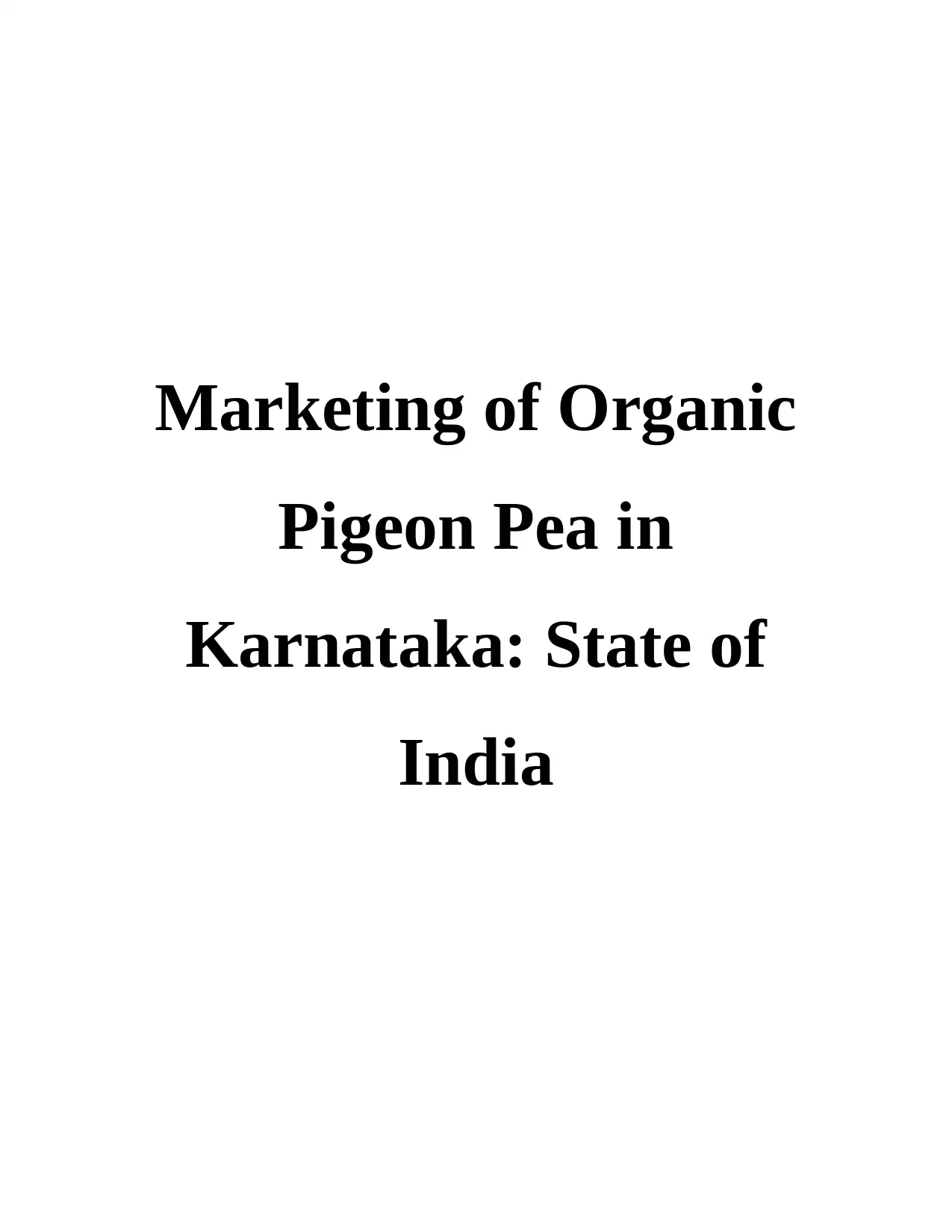
Marketing of Organic
Pigeon Pea in
Karnataka: State of
India
Pigeon Pea in
Karnataka: State of
India
Paraphrase This Document
Need a fresh take? Get an instant paraphrase of this document with our AI Paraphraser
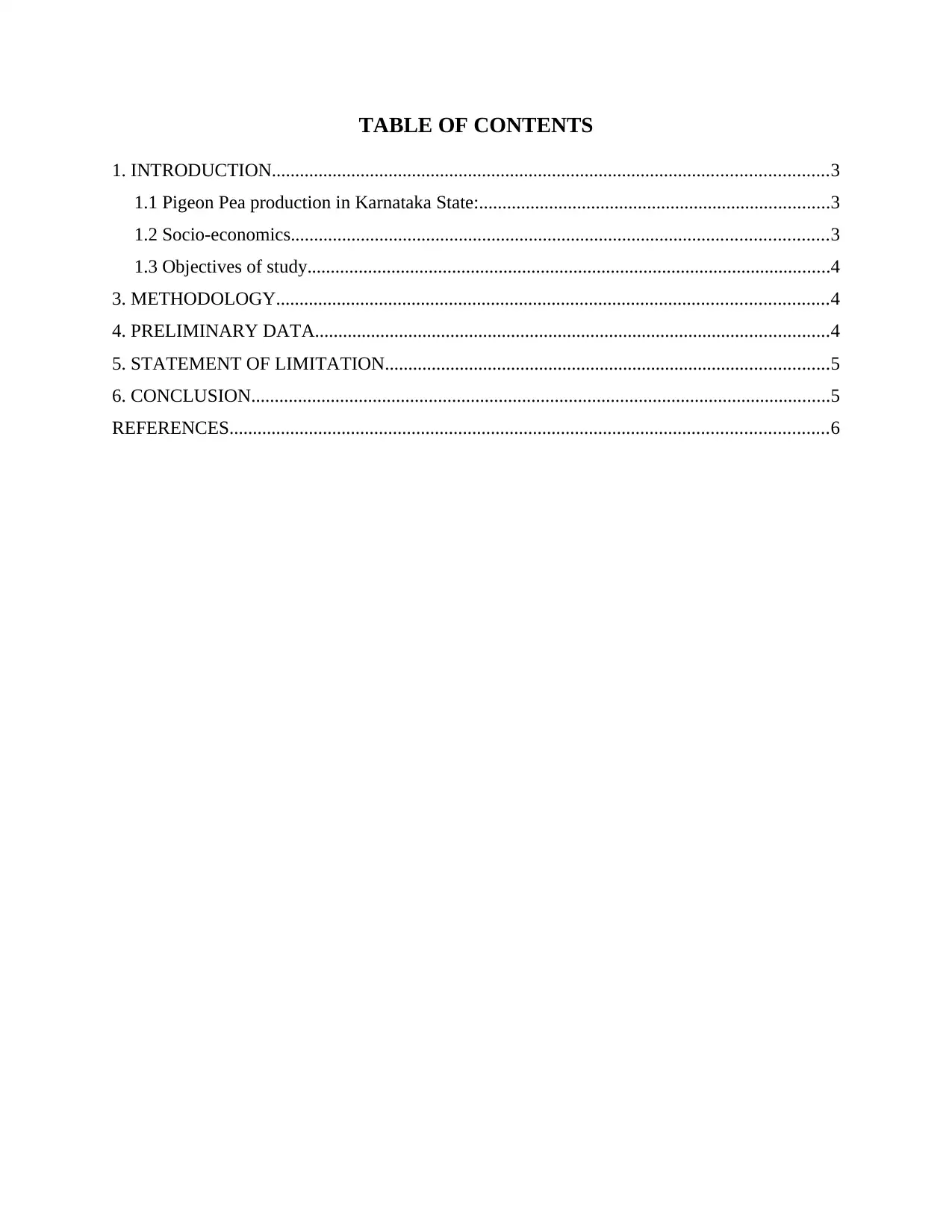
TABLE OF CONTENTS
1. INTRODUCTION.......................................................................................................................3
1.1 Pigeon Pea production in Karnataka State:...........................................................................3
1.2 Socio-economics...................................................................................................................3
1.3 Objectives of study................................................................................................................4
3. METHODOLOGY......................................................................................................................4
4. PRELIMINARY DATA..............................................................................................................4
5. STATEMENT OF LIMITATION...............................................................................................5
6. CONCLUSION............................................................................................................................5
REFERENCES................................................................................................................................6
1. INTRODUCTION.......................................................................................................................3
1.1 Pigeon Pea production in Karnataka State:...........................................................................3
1.2 Socio-economics...................................................................................................................3
1.3 Objectives of study................................................................................................................4
3. METHODOLOGY......................................................................................................................4
4. PRELIMINARY DATA..............................................................................................................4
5. STATEMENT OF LIMITATION...............................................................................................5
6. CONCLUSION............................................................................................................................5
REFERENCES................................................................................................................................6
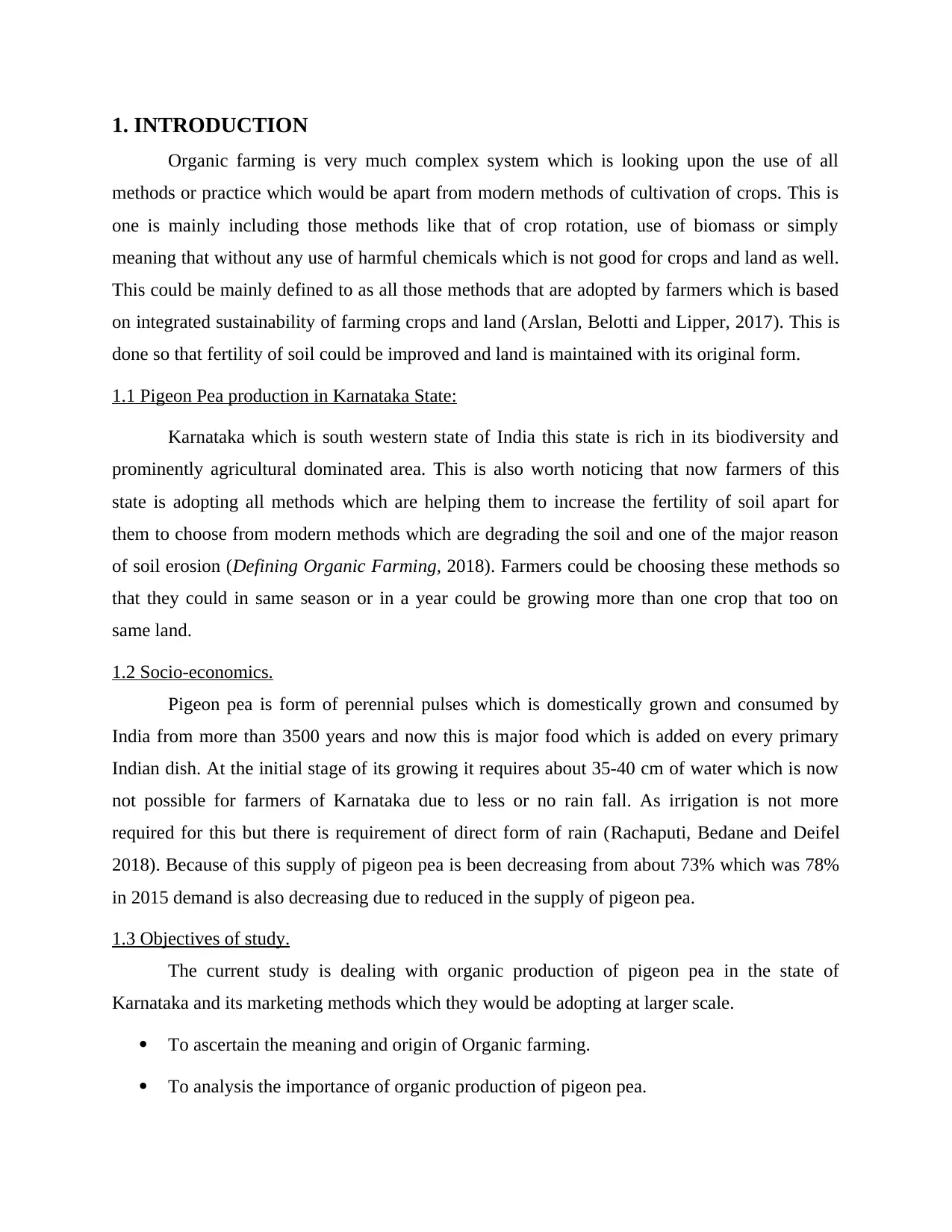
1. INTRODUCTION
Organic farming is very much complex system which is looking upon the use of all
methods or practice which would be apart from modern methods of cultivation of crops. This is
one is mainly including those methods like that of crop rotation, use of biomass or simply
meaning that without any use of harmful chemicals which is not good for crops and land as well.
This could be mainly defined to as all those methods that are adopted by farmers which is based
on integrated sustainability of farming crops and land (Arslan, Belotti and Lipper, 2017). This is
done so that fertility of soil could be improved and land is maintained with its original form.
1.1 Pigeon Pea production in Karnataka State:
Karnataka which is south western state of India this state is rich in its biodiversity and
prominently agricultural dominated area. This is also worth noticing that now farmers of this
state is adopting all methods which are helping them to increase the fertility of soil apart for
them to choose from modern methods which are degrading the soil and one of the major reason
of soil erosion (Defining Organic Farming, 2018). Farmers could be choosing these methods so
that they could in same season or in a year could be growing more than one crop that too on
same land.
1.2 Socio-economics.
Pigeon pea is form of perennial pulses which is domestically grown and consumed by
India from more than 3500 years and now this is major food which is added on every primary
Indian dish. At the initial stage of its growing it requires about 35-40 cm of water which is now
not possible for farmers of Karnataka due to less or no rain fall. As irrigation is not more
required for this but there is requirement of direct form of rain (Rachaputi, Bedane and Deifel
2018). Because of this supply of pigeon pea is been decreasing from about 73% which was 78%
in 2015 demand is also decreasing due to reduced in the supply of pigeon pea.
1.3 Objectives of study.
The current study is dealing with organic production of pigeon pea in the state of
Karnataka and its marketing methods which they would be adopting at larger scale.
To ascertain the meaning and origin of Organic farming.
To analysis the importance of organic production of pigeon pea.
Organic farming is very much complex system which is looking upon the use of all
methods or practice which would be apart from modern methods of cultivation of crops. This is
one is mainly including those methods like that of crop rotation, use of biomass or simply
meaning that without any use of harmful chemicals which is not good for crops and land as well.
This could be mainly defined to as all those methods that are adopted by farmers which is based
on integrated sustainability of farming crops and land (Arslan, Belotti and Lipper, 2017). This is
done so that fertility of soil could be improved and land is maintained with its original form.
1.1 Pigeon Pea production in Karnataka State:
Karnataka which is south western state of India this state is rich in its biodiversity and
prominently agricultural dominated area. This is also worth noticing that now farmers of this
state is adopting all methods which are helping them to increase the fertility of soil apart for
them to choose from modern methods which are degrading the soil and one of the major reason
of soil erosion (Defining Organic Farming, 2018). Farmers could be choosing these methods so
that they could in same season or in a year could be growing more than one crop that too on
same land.
1.2 Socio-economics.
Pigeon pea is form of perennial pulses which is domestically grown and consumed by
India from more than 3500 years and now this is major food which is added on every primary
Indian dish. At the initial stage of its growing it requires about 35-40 cm of water which is now
not possible for farmers of Karnataka due to less or no rain fall. As irrigation is not more
required for this but there is requirement of direct form of rain (Rachaputi, Bedane and Deifel
2018). Because of this supply of pigeon pea is been decreasing from about 73% which was 78%
in 2015 demand is also decreasing due to reduced in the supply of pigeon pea.
1.3 Objectives of study.
The current study is dealing with organic production of pigeon pea in the state of
Karnataka and its marketing methods which they would be adopting at larger scale.
To ascertain the meaning and origin of Organic farming.
To analysis the importance of organic production of pigeon pea.
⊘ This is a preview!⊘
Do you want full access?
Subscribe today to unlock all pages.

Trusted by 1+ million students worldwide
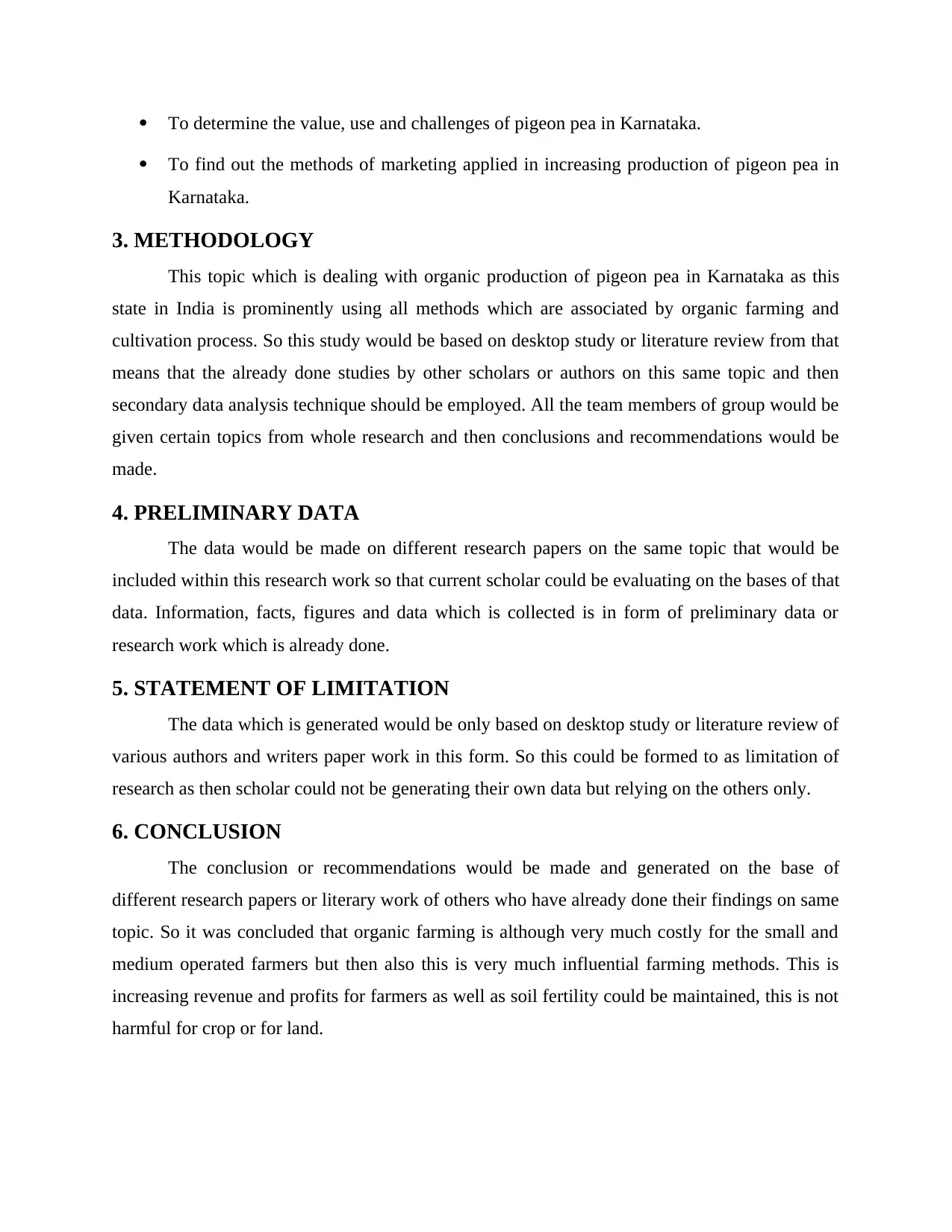
To determine the value, use and challenges of pigeon pea in Karnataka.
To find out the methods of marketing applied in increasing production of pigeon pea in
Karnataka.
3. METHODOLOGY
This topic which is dealing with organic production of pigeon pea in Karnataka as this
state in India is prominently using all methods which are associated by organic farming and
cultivation process. So this study would be based on desktop study or literature review from that
means that the already done studies by other scholars or authors on this same topic and then
secondary data analysis technique should be employed. All the team members of group would be
given certain topics from whole research and then conclusions and recommendations would be
made.
4. PRELIMINARY DATA
The data would be made on different research papers on the same topic that would be
included within this research work so that current scholar could be evaluating on the bases of that
data. Information, facts, figures and data which is collected is in form of preliminary data or
research work which is already done.
5. STATEMENT OF LIMITATION
The data which is generated would be only based on desktop study or literature review of
various authors and writers paper work in this form. So this could be formed to as limitation of
research as then scholar could not be generating their own data but relying on the others only.
6. CONCLUSION
The conclusion or recommendations would be made and generated on the base of
different research papers or literary work of others who have already done their findings on same
topic. So it was concluded that organic farming is although very much costly for the small and
medium operated farmers but then also this is very much influential farming methods. This is
increasing revenue and profits for farmers as well as soil fertility could be maintained, this is not
harmful for crop or for land.
To find out the methods of marketing applied in increasing production of pigeon pea in
Karnataka.
3. METHODOLOGY
This topic which is dealing with organic production of pigeon pea in Karnataka as this
state in India is prominently using all methods which are associated by organic farming and
cultivation process. So this study would be based on desktop study or literature review from that
means that the already done studies by other scholars or authors on this same topic and then
secondary data analysis technique should be employed. All the team members of group would be
given certain topics from whole research and then conclusions and recommendations would be
made.
4. PRELIMINARY DATA
The data would be made on different research papers on the same topic that would be
included within this research work so that current scholar could be evaluating on the bases of that
data. Information, facts, figures and data which is collected is in form of preliminary data or
research work which is already done.
5. STATEMENT OF LIMITATION
The data which is generated would be only based on desktop study or literature review of
various authors and writers paper work in this form. So this could be formed to as limitation of
research as then scholar could not be generating their own data but relying on the others only.
6. CONCLUSION
The conclusion or recommendations would be made and generated on the base of
different research papers or literary work of others who have already done their findings on same
topic. So it was concluded that organic farming is although very much costly for the small and
medium operated farmers but then also this is very much influential farming methods. This is
increasing revenue and profits for farmers as well as soil fertility could be maintained, this is not
harmful for crop or for land.
Paraphrase This Document
Need a fresh take? Get an instant paraphrase of this document with our AI Paraphraser
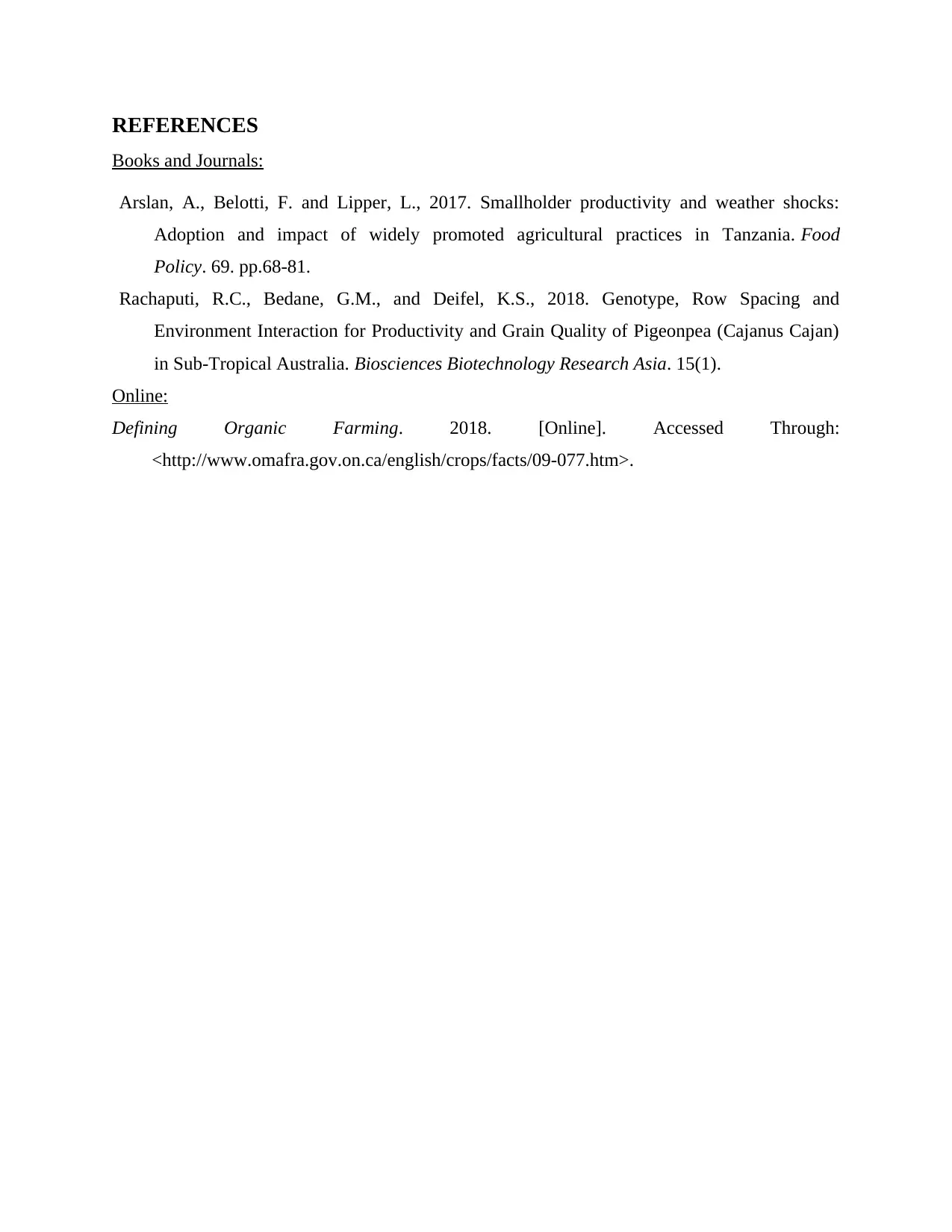
REFERENCES
Books and Journals:
Arslan, A., Belotti, F. and Lipper, L., 2017. Smallholder productivity and weather shocks:
Adoption and impact of widely promoted agricultural practices in Tanzania. Food
Policy. 69. pp.68-81.
Rachaputi, R.C., Bedane, G.M., and Deifel, K.S., 2018. Genotype, Row Spacing and
Environment Interaction for Productivity and Grain Quality of Pigeonpea (Cajanus Cajan)
in Sub-Tropical Australia. Biosciences Biotechnology Research Asia. 15(1).
Online:
Defining Organic Farming. 2018. [Online]. Accessed Through:
<http://www.omafra.gov.on.ca/english/crops/facts/09-077.htm>.
Books and Journals:
Arslan, A., Belotti, F. and Lipper, L., 2017. Smallholder productivity and weather shocks:
Adoption and impact of widely promoted agricultural practices in Tanzania. Food
Policy. 69. pp.68-81.
Rachaputi, R.C., Bedane, G.M., and Deifel, K.S., 2018. Genotype, Row Spacing and
Environment Interaction for Productivity and Grain Quality of Pigeonpea (Cajanus Cajan)
in Sub-Tropical Australia. Biosciences Biotechnology Research Asia. 15(1).
Online:
Defining Organic Farming. 2018. [Online]. Accessed Through:
<http://www.omafra.gov.on.ca/english/crops/facts/09-077.htm>.
1 out of 5
Related Documents
Your All-in-One AI-Powered Toolkit for Academic Success.
+13062052269
info@desklib.com
Available 24*7 on WhatsApp / Email
![[object Object]](/_next/static/media/star-bottom.7253800d.svg)
Unlock your academic potential
Copyright © 2020–2025 A2Z Services. All Rights Reserved. Developed and managed by ZUCOL.




